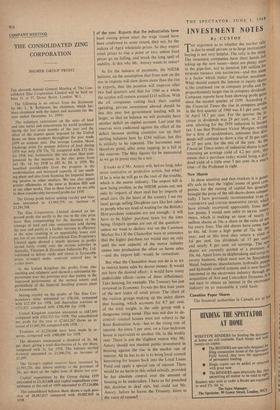INVESTMENT NOTES
By CUSTOS
THE argument as to whether the market rallY is due to small private or to large institutional buying is not very helpful. The rally is the thing. The insurance companies have their hands full taking up the new issues-there are plenty more in the pipe-line, not to mention £40 million for RICHARD THOMAS AND BALDWINS-and this alone is a factor which make. for market steadiness. What should sustain the interest in equity shares is the continued rise in company profits and the proportionately larger rise in company dividends. Company reports have been showing profit gains since the second quarter of 1959. According to the Financial Times the rise in company profits in the first quarter of 1960 was 8.1 per cent. and in April 18.7 per cent. For the quarter the in" crease in dividends was 29 per cent., or 21 Per cent. allowing for the' 1959 reduction in income tax. I see that Professor Victor Morgan, writing for a firm of stockbrokers, estimates that divi- dends will continue to show a rise of 20 per cent' to 25 per cent. for the rest of the year. As the Financial Times index of industrial shares is now returning an average yield of 4.2 per cent., this means that a purchase today would bring a diva' dend yield of a little over 5 per cent. in a years time-if the Professor is right.
New Shares
In these sensitive and thin markets it is gene' ally safe to buy the 'rights' issues of good eorly ',allies, for the raising of capital has generallY brought the price of the old shares down substan- tially. I have previously recommended. TUBE IN VESTMENTS and UNITED DOMINIONS TRUST, Which have already recovered appreciably from their low points. I would now refer to METAL INDUS" TRIES, which is making an issue of nearly 14 million shares at 54s. a share in the ratio of one for every four. The old shares have come back to 64s. 6d. from a high point of 72s. 6d. this, year, and at this level they return a yield 01 4.6 per cent. (on dividends of 15 per cent) and nearly 8 per cent. on earnings. The nevi, shares are currently quoted at a premium 01 10s. 6d. Apart from its shipbreaking and scrap re- covery business, which must now be flourishing' Metal Industries manufactures hydraulic puni,lis and hydraulic control systems and is now heavily interested in the electronics industry through the acquisition of Avo and Lancashire Dynamo. It 15 not easy to obtain an interest in the electronics industry on so reasonable a yield basis.
Canadian Paper Shares
The financial authorities in Canada are at last taking sensible action to wipe out the premium on their dollar which has been discouraging the export trade and encouraging excess borrowing abroad. Last year the Canadian dollar stood at an average premium of 4.3 per cent. over the American dollar and in the first quarter it had risen to over 5 per cent. It is now down to 11 per cent. One of the worst sufferers from this exchange folly was the paper industry. In 1955 the Canadian newsprint companies decided to in- crease their capacities by about 25 per cent.— some companies even by 100 per cent.—and this was completed by 1958 when the exchange Premium was near its peak. To make matters Worse the demand for Canadian newsprint fell away at the same time and the operating ratios 0r the companies dropped to about 85 per cent. of the new capacity. Earnings fell off sharply. Last year there was some recovery and this year American consumption, which takes 80 per cent. of the Canadian output. has increased by just over 11 per cent. Now that the trend of sales and of the Canadian exchange are working in the same direction the outlook for the Canadian newsprint companies is very much brighter. I favour ABITIBI, which is likely to show the biggest rise in profits this year. In 1958 it earned $2.19 Per share and in 1959 $2.72. This year it is expected to earn $3.32—an increase of 22 per Cent. At $75 London the shares return a dividend Yield of 4.2 per cent., which, after double taxation relief, becomes 5.8 per cent. to a British investor.



































 Previous page
Previous page